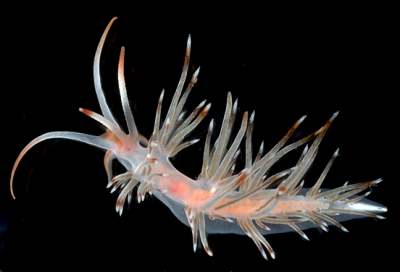
Sakuraeolis nungunoides
Rudman, 1980
Order: NUDIBRANCHIA
Suborder: AEOLIDINA
Family: Glaucidae
DISTRIBUTION
Originally described from Tanzania, East Africa. Also reported on the Forum from New Caledonia & Malaysia, suggesting that it may have a wide Indo-West Pacific distribution.
PHOTO
Lagoon between mainland and Récif de l'Infernet, off Koumac, New Caledonia, 20°34.4'S, 164°13'E, 12m, 18 October 1993, 18mm long alive, AM C200516.
PHOTO: Bill Rudman.
RELATED TOPIC
Defensive coloration in sea slugs
The body is translucent white with tinges of the orange viscera showing through. There is a median orange band on the head from the rhinophores to the oral tentacles. The basal third of the long tapering rhinophores is translucent, the middle third is white, and the upper third orange. The oral tentacles are of similar shape and colour. The anterior edge of the foot and all of the tentacular foot corners are orange, and so is the posterior tip of the foot. The cerata are transparent, or slightly translucent, sometimes with a dusting of white. Near the tip is a broad orange band, the tip itself being opaque white. The thin digestive gland duct is clearly visible and ranges in colour from light greenish brown to a dark chocolate brown.
The animal grows to at least 40mm long. The cerata are usually extremely long, and often held upright. The oral tentacles and the rhinophores are both long and tapering, the rhinophores being slightly shorter. The cerata are arranged in a series of arches down each side of the body, the arches raised on pads out from the body. It feeds on hydroids. In Tanzania it was found feeding on both Salacia tetracythara and Eudendrium sp. cf. carneum.
Many glaucid aeolids are described as being ‘pugnacious’ because they erect their cerata when disturbed. Sakuraeolis nungunoides not only straightens its cerata but it also bristles them, quivering and pointing the red colored tips, containing their cnidosacs, at the source of the irritation. It was this behaviour which caused me to name this animal after the porcupine (Nungunungu in Swahili), which bristles its spines in much the same way when attacked.
-
Rudman, W.B. (1980). Aeolid opisthobranch molluscs (Glaucidae) from the Indian Ocean and the south-west Pacific. Zoological Journal of the Linnean Society, 68: 139-172.
Rudman, W.B., 2003 (May 10) Sakuraeolis nungunoides Rudman, 1980. [In] Sea Slug Forum. Australian Museum, Sydney. Available from http://www.seaslugforum.net/find/sakunung
Related messages
Sakuraeolis nungunoides from Philippines
March 3, 2009
From: Brian Mayes
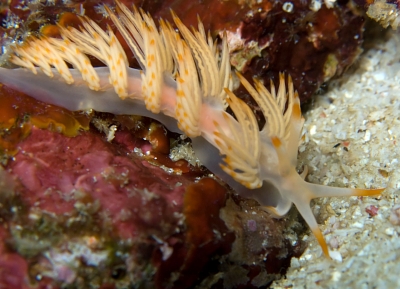
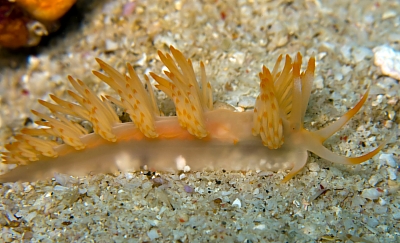
Hi Bill,
I think is Sakuraeolis nungunoides but it seems to lack a significant orange patch between the oral tentacles and the base of the rhinophores. Anyway, I hope you find it useful.
Locality: "Bethlehem", Maricaban Island, 17 metres, Luzon, Philippines, Luzon Sea, 31 January 2009, Channel bottom, sand interspersed with coral. Length: 30 mm. Photographer: Brian Mayes.
Best regards
Brian
brian.r.mayes@gmail.com
Mayes, B.R., 2009 (Mar 3) Sakuraeolis nungunoides from Philippines. [Message in] Sea Slug Forum. Australian Museum, Sydney. Available from http://www.seaslugforum.net/find/22306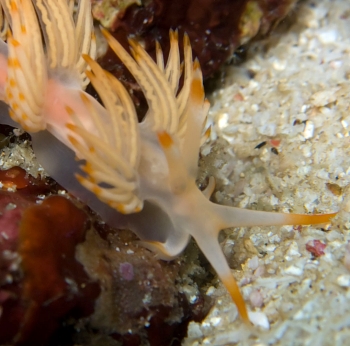
Dear Brian,
I think this is just a pale version. You will see that my photos of animals from New Caledonia have quite a pale orange colouration as well. Any records of this relatively unreported species are welcome
Best wishes,
Bill Rudman
Sakuraeolis nungunoides from New Caledonia
August 29, 2006
From: Jean-François Hervé
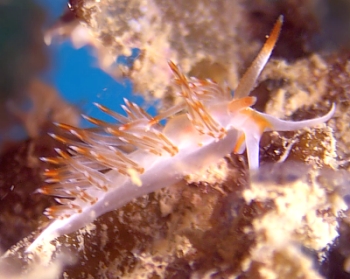
Dear Bill,
Here is a photo of a species that looks like an aeolid. This 20mm specimen was collected from Noumea in 10 m. I would like a species ID please.
Thank you very much.
Locality: Noumea, 10 m, New caledonia, Pacific Ocean, Fevrier 2006. Length: 20 mm. Photographer: Jean-François Hervé.
Jean-François Hervé
jfherve@free.fr
Hervé, J.F., 2006 (Aug 29) Sakuraeolis nungunoides from New Caledonia. [Message in] Sea Slug Forum. Australian Museum, Sydney. Available from http://www.seaslugforum.net/find/17463Dear Jean-François,
This species, Sakuraeolis nungunoides, seems to be well established in New Caledonia. I have seen specimens from both Noumea and the Koumac region in nthn New Caledonia [message #9927 ]
Best wishes,
Bill Rudman
Sakuraeolis nungunoides feeding
June 12, 2006
From: Erwin Koehler
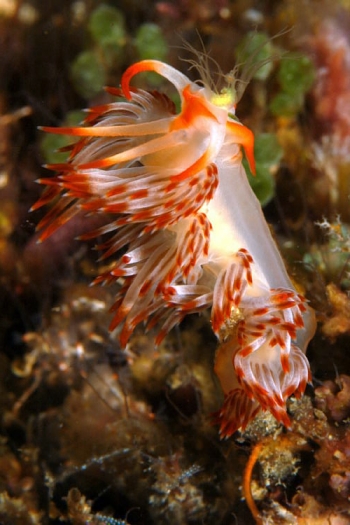
Dear Bill,
Here is a shot of Sakuraeolis nungunoides feeding on a hydoid.
Locality: Gato island, Cave South, 12 m, Philippines, Malapascua island, western Pacific Ocean, 17 April 2005. Length: 35 mm. Photographer: Erwin Koehler.
Regards,
Erwin
Erwin@Philippine-Sea-Slugs.com
Koehler, E., 2006 (Jun 12) Sakuraeolis nungunoides feeding. [Message in] Sea Slug Forum. Australian Museum, Sydney. Available from http://www.seaslugforum.net/find/16827Thanks Erwin,
The hydroid looks like quite a large athecate species. I found this on a species of Eudendrium in Tanzania so it is possible it feeds on a variety of species.
Best wishes,
Bill Rudman
Sakuraeolis nungunoides from Sarawak, Malaysia
June 7, 2006
From: Mike Krampf
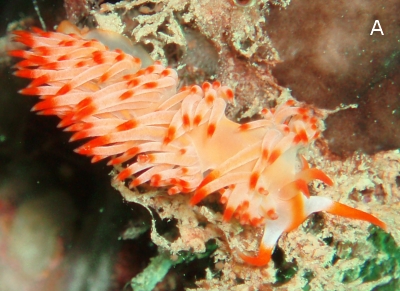
My girlfriend and I were recently diving some patch reefs near Miri in Sabah, Malaysia and took the picture of the two nudibranches shown. They were on the same part of the reef. My girlfriend thinks there are the same species and do not. Can you please help us identify the species and confirm if they are indeed from the same species or not?
Locality: Anenome Garden, 30 feet, Miri, Sarawak, Malaysia, South China Sea, 27 May 2006, Patch Reef. Length: 4 cm. Photographer: Mike Krampf.
Mike Krampf
mtkrampf@yahoo.com
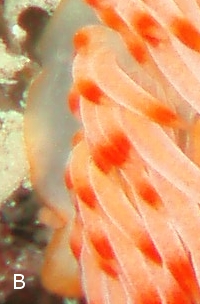
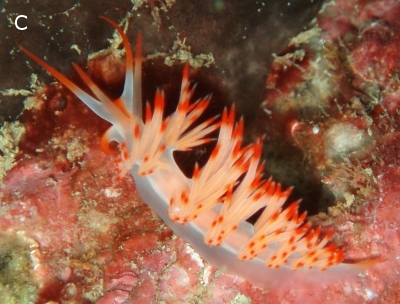
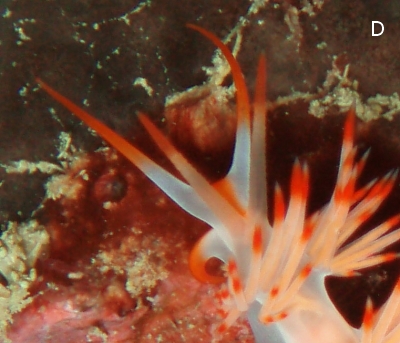
Dear Mike,
I hope you left yourself some room to retreat with dignity because this time your girlfriend was right. It is Sakuraeolis nungunoides. The difference between the two is mainly that in the lower photo the cerata are being held stiff and upright. Many glaucid aeolids erect their cerata like this when disturbed. Sakuraeolis nungunoides not only straightens its cerata but it also bristles them, quivering and pointing the red colored tips, containing their cnidosacs, at the source of the irritation. Porcupines bristle their spines in much the same way when attacked. When I first found this species in East Africa I named it 'nungunoides' after the Swahili word for the porcupine -nungunungu.
It has since been found in many parts of the tropical Indo-West Pacific..
Best wishes,
Bill Rudman
Sakuraeolis nungunoides? from Singapore
April 16, 2005
From: Lim Han Peng
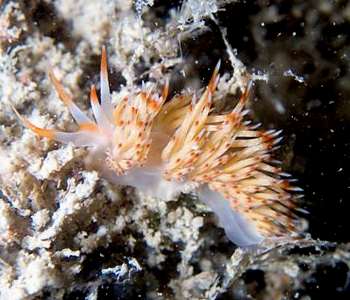
Hi Bill,
sorry to trouble you again.
Is this a colour variation of a Flabellina rubrolineata? I found it at Pulau Hantu, Singapore.
I don't know if I am taking up your precious time to read this mail. Are these findings of ours useful to your research. Actually we found a Glossodoris cincta on the same day too. Do let me know if you want to be informed of our findings.
Locality: Pulau Hantu, Singapore, South China Sea. Depth: 11 m. Length: 20 mm. 20 March 2005. Silt covered hydriod. Photographer: Lim Han Peng
Thanks in advance.
hp
limhp@hotpop.com
Lim, H.P., 2005 (Apr 16) Sakuraeolis nungunoides? from Singapore. [Message in] Sea Slug Forum. Australian Museum, Sydney. Available from http://www.seaslugforum.net/find/13380Dear hp,
The only way I can know if your finds are valuable is to see them. Over the years the Forum has been going, interested amateurs have sent photos and information which has greatly increased our knowledge of these animals worldwide. It is not an exaggeration to say that almost every day I am posting new information on some species or other. Some messages are just simple identifications, but most in one way or another are helping us to accumulate an amazing amount of new information which would otherwise be lost to science. As long as your messages include the information I ask for, I am more than happy to receive them.
This message is a good example. I am pretty sure this is a colour form of Sakuraeolis nungunoides, a species I described from East Africa in 1980. Messages on the Forum have increased its known distribution to Malaysia, eastern Australia and New Caledonia, and your photo helps give us information on possible colour varaibility. The orange tipped rhinophores and oral tentacles and orange mark on the head all seem to be characteristic. Of course I can't be 100% sure without a look at its internal anatomy, but that seems to be the most likely identification.
Best wishes,
Bill Rudman
Sakuraeolis nungunoides from northern N.S.W.
December 28, 2004
From: Denis Riek
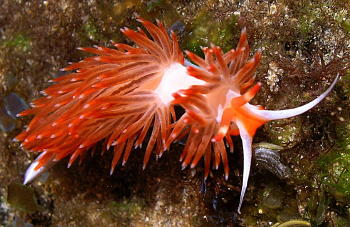
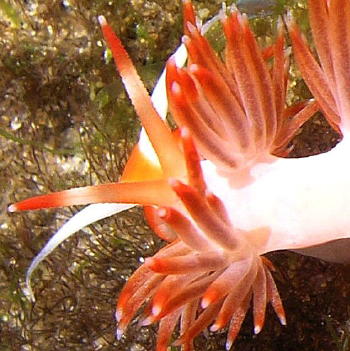
Dear Bill,
Here are some shots of what appears to my untrained eye to be Sakuraeolis nungunoides. Apart from the more intense colour, the only differences I can see are the lack of red tips on the oral tentacles and some orange colour at the base of the rhinophores.The foot is a translucent white and the animal behaved in the way you describe when "annoyed".
I observed at least half a dozen others over a couple of months but all were only approx 8-10mm, while this one, the first I saw, was 30mm. What do you think?
Locality: Brunswick River, nthn New South Wales, Australia
Depth: 4 metres, Length: 30mm. 30 August 2004
On sea wall on algae covered rock
Photographer: Denis Riek
Regards,
Denis.
denisriek@hotmail.com
Riek, D.W., 2004 (Dec 28) Sakuraeolis nungunoides from northern N.S.W.. [Message in] Sea Slug Forum. Australian Museum, Sydney. Available from http://www.seaslugforum.net/find/12840Dear Denis,
Thanks for this interesting find. As you say, apart from the lack of orange on the oral tentacles this animal certainly looks like Sakuraeolis nungunoides. Although described from east Africa, I have since found it in New Caledonia and there are records on the Forum of specimens from Malaysia, so it's not surprising that it occurs as a tropical straggler in nthn New South Wales, though it would be best to have a look at its anatomy to confirm the identification.
Best wishes,
Bill Rudman
Sakuraeolis nungunoides from Malaysia
May 10, 2003
From: Harry Erhardt
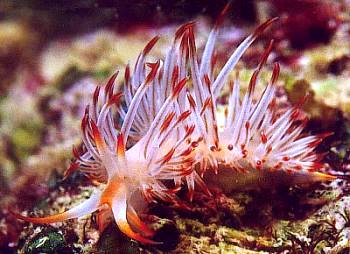
Dear Bill,
Here is perhaps a Phidiana sp from Malaysia.
Mantanani Is, Malaysia. Approx 4m, 24 February 2003. Photo: Harry Erhardt
Harry Erhardt
dr.harry.erhardt@web.de
Erhardt, H., 2003 (May 10) Sakuraeolis nungunoides from Malaysia. [Message in] Sea Slug Forum. Australian Museum, Sydney. Available from http://www.seaslugforum.net/find/9846Dear Harry,
This is an interesting find. It is Sakuraeolis nungunoides, which I first described from Tanzania, and later found in New Caledonia. Your find in Malaysia suggests it has a wide Indo-West Pacific distribution. Your message has also caused me to augment the information I have on the Forum about this species. I have also included messages about the New Caledonian and Tanzanian animals.
Best wishes,
Bill Rudman
Sakuraeolis nungunoides from New Caledonia
May 10, 2003
From: Bill Rudman
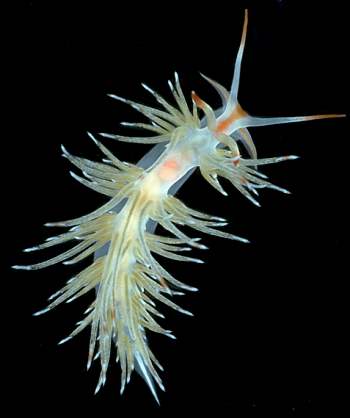

Here are two records of Sakuraeolis nungunoides from New Caledonia
Upper Photo: Lagoon between mainland and Récif de l'Infernet, off Koumac, New Caledonia, 20°34.4'S, 164°13'E, 12m, Silty bottom with dense gorgonian beds, 4 October 1993, 26mm long alive, AM C200325
Lower Photo: Lagoon between mainland and Récif de l'Infernet, off Koumac, New Caledonia, 20°34.4'S, 164°13'E, 12m, Silty bottom with dense gorgonian beds 18 October 1993, 10,10,16,17,18,19mm long alive, AM C200516.
Originally described from Tanzania, these records from New Caledonia, and Harry Erhardt's record from Malaysia, suggest it has a wide Indo-West Pacific distribution.
Best wishes,
Bill Rudman
Sakuraeolis nungunoides from Tanzania
May 10, 2003
From: Bill Rudman
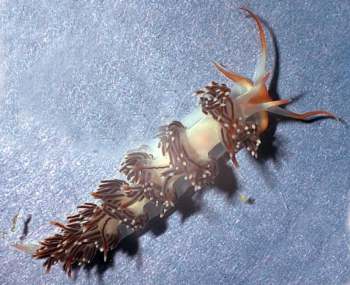
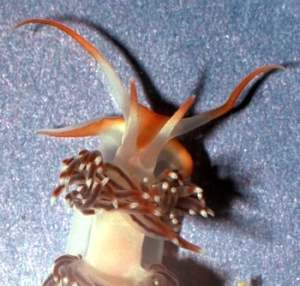
Here is a photo on one of the specimens of Sakuraeolis nungunoides I collected in from Tanzania. They were found feeding on two hydroids, Salacia tetracythara and Eudendrium sp. cf. carneum.
North Reef, entrance to harbour, Dar es Salaam, Tanzania. 29 September 1977. On hydroid covered wooden piles supporting sewerage pipe. Paratype, 40mm long alive. AM C111490.
In this photograph the cerata are atypically short, but it shows the normal colour pattern. Sometmes when stressed the cerata contract like this temporarily.
Best wishes,
Bill Rudman
